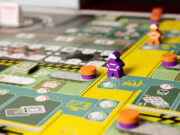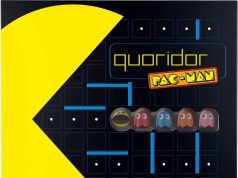 I have been playing board games for a long time. I have played, or at least collected, my fair share of fantasy dungeon crawlers, zombie games, and even Mediterranean trading game. At this point, a unique theme will catch my eye more easily than the 72nd Cthulhu-themed game.
I have been playing board games for a long time. I have played, or at least collected, my fair share of fantasy dungeon crawlers, zombie games, and even Mediterranean trading game. At this point, a unique theme will catch my eye more easily than the 72nd Cthulhu-themed game.
I also enjoy most games published by Stonemaier Games. Wingspan and Rolling Realms are in my “most likely never to be sold” pile.
When a uniquely themed game is released Stonemaier Games, it is a no-brainer that I need to at least check out the game. Well, I was lucky enough to receive a review copy of Stamp Swap. Yes, it is a game about the cutthroat world of… stamp collecting.
So, did Stamp Swap deliver, or should it be canceled (… like a canceled stamp, not THAT kind of canceled)?
Gameplay Overview:
Stamp Swap is a competitive “I split/you choose” tile placement game for one to five stamp collectors (players). Games last between 20 and 75 minutes, depending on player count.

Games consist of three rounds. Each round is divided into three phases:
- Collect Phase
- Players take turns drafting from a randomized pool of stamps, as well as specialist and exhibitor cards, until every player has six items
- Swap Phase
- Players reserve one item, then divide the remaining five items into two separate groups. The first player then picks one of their opponent’s piles. That opponent keeps the unselected pile, and then selects a pile from one of their opponents. This repeats until every player has two piles.
- If a player does not have either pile taken, they keep both their original piles
- Show Phase
- Players simultaneously place their stamps in their albums and score points for the round, including choosing which of the four contests they will score this round
There is a Final Show after the third round is completed where end game scoring is completed. The player with the most points is crowned world champion of board game Stamp Collecting ™!

Game Experience:
What made me feel like when a crowdfunded game is delivered early:
This is the best use of the “I split/you choose” mechanic in board gaming. First, some of the items that you draft are face down. You cannot look at them (unless you have an ability that allows you to) before you select the item. Once you pick it, you can look. This creates an additional layer when creating your offer piles. For example, do you put all your face-down stamps in one pile, and all your face-up stamps in the other? Do you mix them together, hoping to show a face-up tile that is valuable, but grouped with two negative valued face-down stamps? On top of that, the specialist and exhibitor cards can be offered, as well as the first player token. The number of different ways to build your offer is fantastic. The only limitation is that, after reserving an item, you only have five items to split, and no pile can be empty. So your piles will either be one and four or two and three. I wish the draft consisted of eight items with one item reserved.

I also loved puzzling out when to score the contest cards at the end of each round. There are four contests. At the end of a round, you place one of your tickets under a contest. You then score that contest immediately and for that round only. In the next round, you cannot choose a contest you have already entered. Trying to maximize these points is crucial to winning the game. Some of the contests are shorter term (four points per large square stamp, for example), while others are longer-term (six points per large square stamp in a group). What makes these contests even more game-changing is that each of the four contests has six different variations, from which one is selected at the start of each game. This greatly increases the replay value of Stamp Swap!
Finally, the game, once it is learned and understood (see my comments below), plays very fast. The game is only three rounds long, and one phase is simultaneous. You can finish a four-player game in 30-45 minutes if everyone knows what they are doing. The decisions space, between creating your piles, figuring out which stamps work best for you, and trying to maximize your points through the value of the stamps and the contests, is one of the best I have experienced in a game that is this short. I felt like I was constantly balancing what to do with what other might do and I loved that part of Stamp Swap.
What made me feel like when a crowdfunded game is available in retail first:
My biggest disappointment with Stamp Swap is the game rules. Some seem unnecessary or unwieldy. There are also issues with how the rules are presented. Here are some examples:

• Round setup – event cards are used to create the pool of items – some are face up, some are face down. On top of this, based on how the cards are stacked, one event will be showing. That event will be active for that round. This is very convoluted in practice. Unless you split all the different stamp types among the players, only one person can create the pool. This can take a bit of time. It just feels very… rough. There had to be an easier way to set up the pool. On top of this, you must remember that one of the cards has an event that applies. I get why they wanted a variety of events to differentiate each drafting phase; however, I feel like there could have been a better way to design this.
• Specialist cards are active upon selecting them—we missed this our first game because we assumed that you did not own them since you have yet to split them into piles for your opponents. We were incorrect. You have the power until someone else takes a pile it is in. If no one takes it, you will keep the power and it is still active for you. It was weird to have a power for something you “technically” did not yet own.
• Forever Stamps – the rulebook states that, in a two-player game only, there is an imaginary player who collects three forever stamps for scoring purposes. This is not on the board where it lists how to do final scoring. This is not on the player aid. You must remember this.

• Card explanations – After seeing how well Wingspan utilized an appendix to explain all of the card abilities, I was shocked that the same treatment was not applied to this game. The rulebook is 12 pages long. It includes SOME explanation of events or specialist cards, but not all of them. I am not sure why they didn’t do an easy summary by adding a couple of pages to the rulebook.
My second issue is the lack of challenge in utilizing the album. It is too big. You will easily fit every stamp you collect during the game. The ‘puzzle” to place your stamps is not a puzzle at all, except for MAYBE in the third round when it comes to maximizing your points. I was excited at the prospect of this polyomino puzzle, but disappointed in its execution.
Finally, it was difficult for me to distinguish between the colors as well as the themes of the stamps, especially in my first game. There are colorblind indicators, which helped; however, I still had a hard time differentiating yellow and green. I had to take off my glasses and put my face 4 inches from the board to do so. The themes are easy to differentiate once you pick up on the different backgrounds. Again, I needed to get really close to tell the differences. I would not mention this issue if it only happened to me, but literally every player had a hard time the first game they played.
Final Thoughts:
I enjoyed Stamp Swap. In my opinion, “I split/you choose” is the most underutilized mechanic in board gaming. Stamp Swap is the best example of this mechanic in action. Unfortunately, a game that should be fast-paced gets bogged down with some strange rules as well as the first game turning people off from future plays. I recommend trying a copy before buying it. This will be a good, maybe even a great, game for some gaming groups; however, it does not have the mainstream appeal of Wingspan or Rolling Realms.
Final Score: 3 Stars – A good “I split/you choose” game with a unique theme that would have benefited from more polish
 Hits:
Hits:
• The best use of the “I split/you choose” mechanic in a board game
• Unique contest scoring
• Plays quickly once you know the game
Misses:
• Unpolished rules
• Album is so large it makes tile placement too easy
• First game can be difficult to learn





















